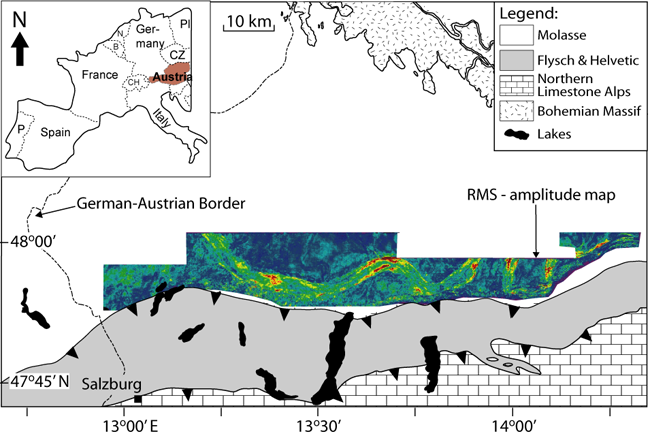Towards the inversion of tectonic signals from deep-marine archives: Competing tectonic signal propagation from across the Alps into the marine sink
This project is a cooperation between the FU Berlin and the University of Potsdam. The RAG Austria AG provides the 3D seismic-reflection data, sediment core and financial funds.
PIs: Anne Bernhardt, Edward Sobel
PhD student: Julian Hülscher
The sedimentary fill of peri-orogenic basins is a product of the interplay between tectonics, climate, sediment transport, and transient storage processes. In turn, marine and terrestrial sediment archives of such basins are often used to reconstruct past tectonic activity and mountain building over various time scales of Earth history. However, our ability to quantitatively assess how changes in tectonic exhumation influence terrestrial erosion and sediment budgets, and how and at what rate these signals propagate through sediment-routing systems into the marine sedimentary archives is severely limited. Moreover, these signals may be modified, dampened or even destroyed along their travel paths. Hence, we need to quantify the travel times of tectonic signals into the stratigraphic record and the imprint of these signals on the resulting stratigraphy. This is important to interpret sedimentary archives correctly and to ultimately invert these archives to the upland control factors that shaped these sedimentary successions.
A key area to investigate such signals is the Northern Alpine Foreland Basin due to its large amount of available data in the Alpine source area and its foreland. Three major tectonic exhumation and uplift events occur during the late Oligocene to middle Miocene in the Alps: the exhumation of Penninic units in the Lepontine Dome and the Tauern Window, and the uplift of paleosurfaces in the Northern Calcareous Alps. Each of these tectonic events is characterized with a unique sediment-provenance signature that allow us to estimate how and at what rate these tectonic signals propagate in Late Oligocene to Miocene sediments and how they are manifested in the sedimentary sink over time. Therefore, the sedimentary successions in the Upper Austrian Molasse Basin will be investigated using 3D seismic-reflection data covering 3300 km2 and with sedimentary analyses from sediment core and outcrop. To analyze the sedimentary succession for the unique tectonic exhumation and uplift signatures, heavy mineral-assemblage analyses will be combined with apatite thermochronology (U/Pb, AFT, AHe), apatite geochemistry, and Nd and Sm isotopic composition of apatite and mudstone. For the determination of lag times between the individual exhumation and uplift events in the Alps and the arrival of its sedimentary response in the Molasse Basin, the marine biostratigraphy of this basin will be re-evaluated using foraminifers, nanofossils and ∂13C stratigraphy. Our results will quantify sediment volumes exported to the Upper Austrian Molasse and determine travel time and mode of distinct tectonic exhumation and uplift signals into the adjacent sedimentary archives. The quantification of the travel times and the expression of these tectonic signals in the deep-marine stratigraphic record are crucial in our strive to correctly interpret marine sediment archives and to ultimately be able to invert these stratigraphic records into their upland forcings.
Outline of the Austrian Molasse study site including three-dimensional seismic-reflection data and sediment core provided by the RAG Austria AG (Vienna).
Outcrop of Miocene Freshwater Molasse in the German Molasse Basin. PhD student Julian Hülscher for scale.

